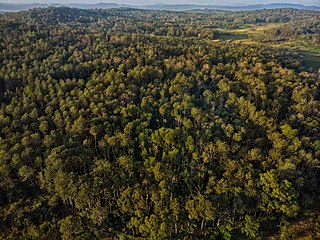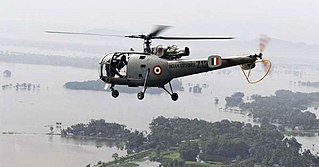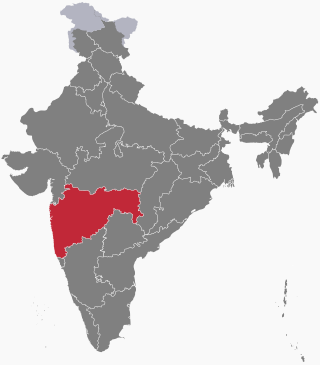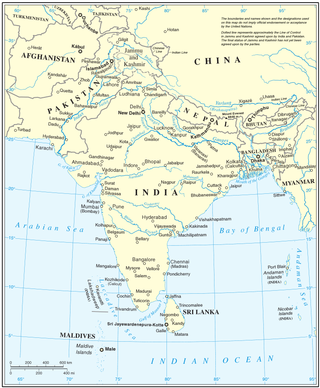
Malnad is a region in the state of Karnataka, India. Malenadu covers the western and eastern slopes of the Western Ghats mountain range and is roughly 100 kilometers in width. It includes the districts of Uttara Kannada, Chikkamagaluru, Udupi, Belagavi, Dakshina Kannada, Hassan, Kodagu, Shivamogga. The region experiences heavy annual rainfall of 1,000–3,800 millimetres ; it includes the village of Agumbe, which receives the highest annual rainfall in Karnataka.

The National Disaster Response Force (NDRF) is a specialized force in India, tasked with the responsibility of responding to natural and man-made disasters. It operates under the National Disaster Management Authority of Ministry of Home Affairs and was established in 2006 with the aim of strengthening disaster management capabilities in the country
Operation Madad is the name of rescue operations conducted by Indian Navy in various occasions within India. The word "madad" in Hindi means "help".

In September 2014, the Kashmir region suffered disastrous floods across many of its districts caused by torrential rainfall. The Indian state of Jammu and Kashmir, as well as the Pakistani territories of Azad Kashmir, Gilgit-Baltistan and the province of Punjab were affected by these floods. By 24 September 2014, nearly 277 people in India and about 280 people in Pakistan had died due to the floods.
This is a list of notable recorded floods that have occurred in India. Floods are the most common natural disaster in India. The heaviest southwest, the Brahmaputra, and other rivers to distend their banks, often flooding surrounding areas.

Deep Depression ARB 02 was a weak tropical cyclone which brought heavy rains and flooding to the Indian state of Gujarat in June 2015. It was the third tropical cyclone and second deep depression of the 2015 North Indian Ocean cyclone season.

Following heavy rain, Gujarat state of India was affected by the flood in July 2015. The flood resulted in at least 72 deaths.

The 2015 Chennai floods resulted from heavy rainfall generated by the annual northeast monsoon in November–December 2015. They affected the Coromandel Coast region of the South Indian states of Tamil Nadu and Andhra Pradesh. More than 500 people were killed and over 1.8 million people were displaced. With estimates of damages and losses ranging from nearly ₹200 billion (US$2 billion) to over ₹1 trillion (US$12 billion), the floods were the costliest to have occurred in 2015, and were among the costliest natural disasters of the year.

Following heavy rain in July 2017, the Indian state of Gujarat was affected by severe flooding. The floods were reported to have caused total 224 deaths between 1 June and 31 July 2017. 16 people had died in neighbouring Rajasthan state by 31 July.

Following heavy rain in July and August 2017, the Indian state of West Bengal was affected by severe flooding. The floods were reported to have caused 50 deaths since 1 August and 8 deaths in the neighbouring state of Jharkhand.
The Brahmaputra floods refers to a catastrophic flood event that occurred in 2012 along the Brahmaputra River and its tributaries, as well as in subsequent years.
2018 Sri Lanka floods and landslides caused from an annual heavy southwest monsoon beginning around 19 May. As of 26 May 2018; the monsoon floods affected in about 19 districts, killed at least 21 people, about 150, 000 people were affected and further left approximately 23 people missing. The death casualties were reported from 22 May onwards in the provinces including South, Northwest, North and East. About 4 people were reported dead due to lightning, 5 people were killed due to floods and lightning, 8 people died due to drowning and further left 4 people dead resulting from fallen trees. The DMC report claimed about 400, 000 people have been displaced to safer locations. About 105 houses were reported to have fully damaged and over 4832 houses have been partially damaged.
In mid-March 2019, monsoonal downpours caused widespread flooding and landslides across South Asia.

On 8 August 2019, due to heavy rainfall in the monsoon season, severe flood affected Kerala. As a security measure in the prevailing situation of heavy rains, the India Meteorological Department had issued a red alert in the 9 districts in Northern and Central Kerala, orange alert in 3 districts of Central Kerala, and yellow alert in the 2 districts of southern Kerala. Thousands of people have been evacuated to safer places and relief camps. A total of 121 people have died due to rain-related incidents as of 19 August 2019.
The 2019 Indian floods were a series of floods that affected over thirteen states in late July and early August 2019, due to excessive rains. At least 200 people died and about a million people were displaced. Karnataka and Maharashtra were the most severely affected states. People died but many were rescued with the help of the Indian Navy.

2020 Assam floods refers to the significant flood event of the Brahmaputra River in the Indian north-eastern state of Assam and coincided with the COVID-19 pandemic. Initial flooding started in May 2020 due to heavy rainfall affecting 30,000 and destroying crops across 5 districts. As of October 2020 the floods affected over five million people, claiming the lives of 123 people, with an additional 26 deaths due to landslides, 5474 villages were affected and over one hundred and fifty thousand people found refuge in relief camps.

During the heavy rainfall over the monsoon period from 1 June to 18 August 2020, all 14 districts in Kerala were affected with 104 dead and 40 injured. Four districts in Kerala were flooded on 7 August 2020. Major reported incidents in relation to flooding include a landslide in Idukki district on 6 August, claiming 66 lives and an Air India plane crash that caused the death of 21 people. The 2020 flood in Kerala marked the third year in a row of severe monsoon flooding.

A series of floods took place across the Indian State of Maharashtra in 2021. As of 28 July 2021, around 251 people have died and over 100 are still missing due to floods and landslides. 13 districts have been affected in western Maharashtra. Damage was calculated to be Rs4,000 crore.

Beginning in May 2022, deadly floods hit northeastern India and Bangladesh. Over 9 million people in both countries have been affected, and around 300 people were killed.

From January to October 2022, excessive rainfall and widespread monsoon flooding occurred in the South Asian countries of Afghanistan, Bangladesh, India, Nepal, Pakistan, and Sri Lanka. It has become the region's deadliest floods since 2020, with over 4,700 people dead.













